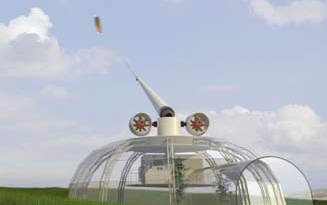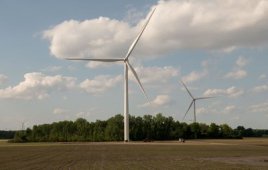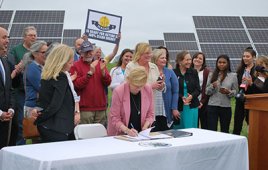Nobody can accuse Italian wind-turbine designers of not thinking big. They say conventional wind turbines just scratch the surface in a few favorable locations on what is an enormous energy field. Current designs cannot reach upper altitude winds and are close to dimensional limits. For instance, there is difficultly positioning hubs at over 100 m up, towers grows exponentially heavier and more unstable than previous designs, and above all, they are more expensive with height. Now consider that the flight-prohibited area over a nuclear power plant can easily contain 1 GW of wind power, equal to the power the plant generates. You’re getting the picture.
 To reach wind over 500 m and exploit its greater kinetic energy, the Kite Gen project starts from a change of perspective: no heavy designs like current wind turbines, but instead, light and dynamic structures. To extract energy from an altitude of 800 to 1,000 m, this design suggests using power kites, semi-rigid automatically piloted high efficiency air foils. All the heavy machinery for power generation remains on the ground. Two cables connect each the kites to a winch to control the kite’s direction and angle to the wind. The winches then sit on a large-diameter carrousel.
To reach wind over 500 m and exploit its greater kinetic energy, the Kite Gen project starts from a change of perspective: no heavy designs like current wind turbines, but instead, light and dynamic structures. To extract energy from an altitude of 800 to 1,000 m, this design suggests using power kites, semi-rigid automatically piloted high efficiency air foils. All the heavy machinery for power generation remains on the ground. Two cables connect each the kites to a winch to control the kite’s direction and angle to the wind. The winches then sit on a large-diameter carrousel.
The Kite Gen concept is comparable to a wind turbine in that the blade tips are the most efficient part of a rotor, say proponents, because they reach highest speeds. The generator is then conveniently located on the ground. The resulting structure is much lighter and cheaper than a conventional design. Moreover, a kite’s operating height can be adjusted to wind conditions.
Several winches or kite steering units, pilot the kites over a predefined flight path. A video at kitegen.com shows some detail. The power kite is maneuvered by unrolling and recovering the two lines, each on the motor-driven winch.
Each Kite Gen power plant is composed by several steering units pulled by power kites along a circular track at ground level. Control software also receives data from on-board avionic sensors to pilot the power kites, control their flight patterns, and maximize energy production.
Conventional wind turbines must be spaced to avoid shading one another which would decrease the total yield. A wind farm can require more than 40 km². In contrast, a Kite Gen power plant and a safe area around it would use about 5 km². Energy production takes place in a distributed manner from several generators thus avoiding unmanageable sizes to electrical equipment.
 The modular approach makes possible to build powerful Kite Gen plants. For example, a 100 MW Kite Gen power plant, not much larger than the illustrated example, would have a ground level diameter of about 1 km and deliver an estimated energy at a cost of less than €0.03/kWh. At this writing, a 1,000 MW plant is under study. The exponential growth of the total wind power that can be harnessed is the main reason behind larger Kite Gen power plants.
The modular approach makes possible to build powerful Kite Gen plants. For example, a 100 MW Kite Gen power plant, not much larger than the illustrated example, would have a ground level diameter of about 1 km and deliver an estimated energy at a cost of less than €0.03/kWh. At this writing, a 1,000 MW plant is under study. The exponential growth of the total wind power that can be harnessed is the main reason behind larger Kite Gen power plants.
Proponents say the scalability of the Kite Gen power plants comes without significant structural or cost constraints because of the design’s modularity. For example, it would allow adding steering units (winches and kites) to produce energy from a larger diameter.
In scaling up plant dimensions, one idea researchers plan to explore is converting mechanical energy into electrical energy by running linear-magnetic motors in reverse.
The theoretical boundaries of such configuration appears to be a ring of about 25-km diameter, which would be the stator on which rotates a magnetically levitated Kite Gen. The tethered high power kites in such a size would fly at up to 10 km in a controlled formation, generating more than 60 GW.
::Windpower Engineering::
Filed Under: Uncategorized





that is if you’re talking about the second one
your right, it won’t work how would it spin
Actually, the over 30 companies have working energy kite systems. They, in part, are gathering at EnergyKiteSystems.net where over 300 links will lead you to a robust awareness of what is known to work.
Anyone who has ever flown a kite knows that this wont work.